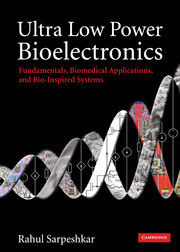Book contents
- Frontmatter
- Contents
- Acknowledgements
- Section I Foundations
- Section II Low-power analog and biomedical circuits
- Section III Low-power RF and energy-harvesting circuits for biomedical systems
- Section IV Biomedical electronic systems
- 19 Ultra-low-power implantable medical electronics
- 20 Ultra-low-power noninvasive medical electronics
- Section V Principles for ultra-low-power analog and digital design
- Section VI Bio-inspired systems
- Section VII Energy sources
- Bibliography
- Index
- Epilogue
- References
20 - Ultra-low-power noninvasive medical electronics
from Section IV - Biomedical electronic systems
Published online by Cambridge University Press: 02 December 2010
- Frontmatter
- Contents
- Acknowledgements
- Section I Foundations
- Section II Low-power analog and biomedical circuits
- Section III Low-power RF and energy-harvesting circuits for biomedical systems
- Section IV Biomedical electronic systems
- 19 Ultra-low-power implantable medical electronics
- 20 Ultra-low-power noninvasive medical electronics
- Section V Principles for ultra-low-power analog and digital design
- Section VI Bio-inspired systems
- Section VII Energy sources
- Bibliography
- Index
- Epilogue
- References
Summary
It has long been an axiom of mine that the little things are infinitely the most important.
Sir Arthur Conan DoyleNoninvasive medical electronics refers to electronics for medical instruments that do not invade or penetrate the body. The sensors in these instruments can and often do contact the body. Examples of such sensing include:
Electrocardiogram (EKG or ECG) measurements of heart function.
Photoplethysmographic (PPG) measurements of blood-oxygen saturation, or pulse oximetry.
Phonocardiogram (PCG) measurements of heart sounds.
Electroencephalogram (EEG) measurements of brain function.
Magnetoencephalogram (MEG) measurements of brain function.
Electromyogram (EMG) measurements of muscle function.
Electrooculogram (EOG) measurements of eye motion.
Electrical impedance tomography (EIT): measurements to infer composition of the body's tissues. Impedance cardiography (ICG) is a further specialization within the field.
Temperature measurements.
Blood-pressure (BP) measurements.
Pulmonary auscultation (lung-sound) measurements.
Biomolecular detection of small molecules, DNA, proteins, cells, viruses, or microorganisms for point-of-care or lab-on-a-chip applications, which often exploit BioMEMS (Bio Micro Electro Mechanical Systems) and microfluidic technologies, mostly in a noninvasive fashion thus far.
When such sensing is done chronically, for example as heart tags on patients with a high risk for myocardial infarction (MI), i.e., a heart attack, it is often called wearable electronics. The various sensors on the body may form a body sensor network (BSN) or body area network (BAN) that communicate with each other and/or the patient's cell phone, or with an RF-ID, Bluetooth, Zigbee, MICS, UWB, or other wireless receiver in the home, hospital, or battlefield.
- Type
- Chapter
- Information
- Ultra Low Power BioelectronicsFundamentals, Biomedical Applications, and Bio-Inspired Systems, pp. 579 - 614Publisher: Cambridge University PressPrint publication year: 2010



